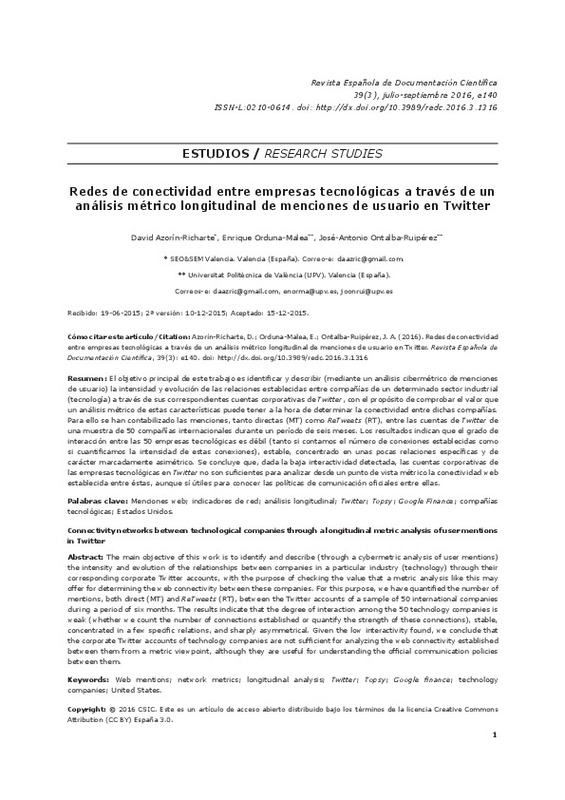Adamic, L. A., & Huberman, B. A. (2001). The Web’s hidden order. Communications of the ACM, 44(9), 55-60. doi:10.1145/383694.383707
Barabási, A.L. (2014). Linked: how everything is connected to everything else and what it means for business, Science, and every day life. New York: Basic Books.
Barabási, A.-L., & Albert, R. (1999). Emergence of Scaling in Random Networks. Science, 286(5439), 509-512. doi:10.1126/science.286.5439.509
[+]
Adamic, L. A., & Huberman, B. A. (2001). The Web’s hidden order. Communications of the ACM, 44(9), 55-60. doi:10.1145/383694.383707
Barabási, A.L. (2014). Linked: how everything is connected to everything else and what it means for business, Science, and every day life. New York: Basic Books.
Barabási, A.-L., & Albert, R. (1999). Emergence of Scaling in Random Networks. Science, 286(5439), 509-512. doi:10.1126/science.286.5439.509
Bollen, J., Mao, H., & Zeng, X. (2011). Twitter mood predicts the stock market. Journal of Computational Science, 2(1), 1-8. doi:10.1016/j.jocs.2010.12.007
Carim, L., & Warwick, C. (2013). Use of social media for corporate communications by research-funding organisations in the UK. Public Relations Review, 39(5), 521-525. doi:10.1016/j.pubrev.2013.08.006
Case, C. J.; King, D. L. (2010). Cutting edge communication: microblogging at the fortune 200, twitter implementation and usage. Issues in information systems, vol. 11(1), 216-223.
Del-Fresno-García, M. (2014). Haciendo visible lo invisible: visualización de la estructura de las relaciones en red en Twitter por medio del análisis de redes sociales. El Profesional de la Informacion, 23(3), 246-252. doi:10.3145/epi.2014.may.04
Gentle, A. (2009). Conversation and community: the social web for documentation. Laguna Hills; XML Press, p. 342.
Huberman, B., Romero, D. M., & Wu, F. (2008). Social networks that matter: Twitter under the microscope. First Monday, 14(1). doi:10.5210/fm.v14i1.2317
Jansen, B. J., Zhang, M., Sobel, K., & Chowdury, A. (2009). Twitter power: Tweets as electronic word of mouth. Journal of the American Society for Information Science and Technology, 60(11), 2169-2188. doi:10.1002/asi.21149
Kietzmann, J. H., Hermkens, K., McCarthy, I. P., & Silvestre, B. S. (2011). Social media? Get serious! Understanding the functional building blocks of social media. Business Horizons, 54(3), 241-251. doi:10.1016/j.bushor.2011.01.005
Ordu-a-Malea, E.; Aguillo, I.F. (2014). Cibermetría: midiendo el espacio red. Barcelona: UOC.
Orduña-Malea, E., Delgado López-Cózar, E., Serrano-Cobos, J., & Romero, N. L. (2015). Disclosing the network structure of private companies on the web. Online Information Review, 39(3), 360-382. doi:10.1108/oir-11-2014-0282
Orduña-Malea, E., Torres-Salinas, D., & Delgado López-Cózar, E. (2015). Hyperlinks embedded in twitter as a proxy for total external in-links to international university websites. Journal of the Association for Information Science and Technology, 66(7), 1447-1462. doi:10.1002/asi.23291
Ortega, J. L., & Aguillo, I. F. (2011). Social Network Tools for the Assessment of the University Web Performance. Social Media Tools and Platforms in Learning Environments, 185-201. doi:10.1007/978-3-642-20392-3_11
Luis Ortega, J., & Aguillo, I. F. (2013). Network visualisation as a way to the web usage analysis. Aslib Proceedings, 65(1), 40-53. doi:10.1108/00012531311297177
Paniagua, J., & Sapena, J. (2014). Business performance and social media: Love or hate? Business Horizons, 57(6), 719-728. doi:10.1016/j.bushor.2014.07.005
Romero-Frías, E. (2011). Googling Companies-a Webometric Approach to Business Studies. Leading Issues in Business Research Methods, vol. 1, 93- 106.
Romero, D. M., Galuba, W., Asur, S., & Huberman, B. A. (2011). Influence and passivity in social media. Proceedings of the 20th international conference companion on World wide web - WWW ’11. doi:10.1145/1963192.1963250
Rybalko, S., & Seltzer, T. (2010). Dialogic communication in 140 characters or less: How Fortune 500 companies engage stakeholders using Twitter. Public Relations Review, 36(4), 336-341. doi:10.1016/j.pubrev.2010.08.004
Shu, Z. (2015). How do technical companies use microblogging?. Twente; University of Twente, p. 300.
Stieglitz, S.; Krüger, N. (2011). Analysis of Sentiments in Corporate Twitter Communication –A Case Study on an Issue of Toyota. 22nd Australasian conference on information systems - ACIS 2011 Proceedings, pp. 1-11 [paper 29]. Sydney, Australia: ACIS. http://aisel.aisnet.org/acis2011/29 [fecha de consulta: 12-03-2015]
Thelwall, M. (2004). Link analysis: An information science approach. Amsterdam: Elsevier.
Vaughan, L. (2004). Exploring website features for business information. Scientometrics, 61(3), 467-477. doi:10.1023/b:scie.0000045122.93018.2a
Vaughan, L., & Romero-Frías, E. (2012). Exploring Web keyword analysis as an alternative to link analysis: a multi-industry case. Scientometrics, 93(1), 217-232. doi:10.1007/s11192-012-0640-x
Vaughan, L., & Wu, G. (2004). Links to commercial websites as a source of business information. Scientometrics, 60(3), 487-496. doi:10.1023/b:scie.0000034389.14825.bc
Vaughan, L., & Yang, R. (2013). Web traffic and organization performance measures: Relationships and data sources examined. Journal of Informetrics, 7(3), 699-711. doi:10.1016/j.joi.2013.04.005
Vaughan, L., & You, J. (2006). Comparing business competition positions based on Web co-link data: The global market vs. the Chinese market. Scientometrics, 68(3), 611-628. doi:10.1007/s11192-006-0133-x
Vaughan, L., & You, J. (2010). Word co-occurrences on Webpages as a measure of the relatedness of organizations: A new Webometrics concept. Journal of Informetrics, 4(4), 483-491. doi:10.1016/j.joi.2010.04.005
Wamba, S. F., & Carter, L. (2013). Twitter Adoption and Use by SMEs: An Empirical Study. 2013 46th Hawaii International Conference on System Sciences. doi:10.1109/hicss.2013.577
Williams, S. A., Terras, M. M., & Warwick, C. (2013). What do people study when they study Twitter? Classifying Twitter related academic papers. Journal of Documentation, 69(3), 384-410. doi:10.1108/jd-03-2012-0027
Zimmer, M., & Proferes, N. J. (2014). A topology of Twitter research: disciplines, methods, and ethics. Aslib Journal of Information Management, 66(3), 250-261. doi:10.1108/ajim-09-2013-0083
[-]









